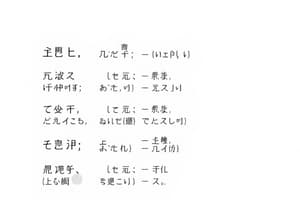Podcast
Questions and Answers
Which of the following correctly describes verb conjugation?
Which of the following correctly describes verb conjugation?
- Using a consistent pattern to change the form of adjectives.
- Altering a verb's form based on tense, mood, person, and number. (correct)
- Changing a noun to indicate its grammatical case.
- Applying an inflectional ending to a word without changing its meaning.
Inflectional endings can change the meaning of a word and its part of speech.
Inflectional endings can change the meaning of a word and its part of speech.
False (B)
What is the purpose of pluralization rules?
What is the purpose of pluralization rules?
To indicate more than one of a noun.
The verb 'to run' can change to 'running' by adding the ______ ending.
The verb 'to run' can change to 'running' by adding the ______ ending.
Match the following examples to their corresponding rules:
Match the following examples to their corresponding rules:
Which examples are considered irregular plural nouns?
Which examples are considered irregular plural nouns?
Regular verbs follow predictable patterns of conjugation.
Regular verbs follow predictable patterns of conjugation.
What does tense variation indicate?
What does tense variation indicate?
Flashcards
Inflectional Endings
Inflectional Endings
Changes in a word's form to show grammatical relationships (e.g., tense, number).
Verb Conjugation
Verb Conjugation
Changing a verb's form to show tense, person, and number.
Pluralization Rules
Pluralization Rules
How nouns change to show more than one.
Tense Variations
Tense Variations
Signup and view all the flashcards
Noun Inflection
Noun Inflection
Signup and view all the flashcards
Regular Verbs
Regular Verbs
Signup and view all the flashcards
Irregular Verbs
Irregular Verbs
Signup and view all the flashcards
Grammatical Categories
Grammatical Categories
Signup and view all the flashcards
Study Notes
Inflectional Endings
- Inflectional endings are changes in the form of a word to indicate grammatical relationships.
- These changes often indicate grammatical categories such as tense, person, number, case, or gender.
- They are distinct from derivational affixes, which alter the word's meaning and part of speech.
- Inflectional endings provide context and meaning within a sentence.
- Examples of inflectional endings frequently seen are: -s, -ed, -ing, -er, -est.
Verb Conjugation
- Verb conjugation refers to the systematic variation of a verb's form to indicate tense, mood, person, and number.
- It shows how a verb changes its form depending on its syntactic function.
- Conjugation often involves replacing an entire stem portion of the word with alternative forms.
- Regular verbs follow predictable patterns of conjugation.
- Irregular verbs do not follow these predictable patterns and require memorization of the alternate forms.
- Conjugations vary significantly across different languages.
Pluralization Rules
- Pluralization rules govern how nouns change form to indicate more than one.
- These rules often involve the addition of an ending, such as -s or -es.
- Some nouns change their vowel sounds or stem completely to indicate the plural form.
- Pluralization patterns may differ for countable and uncountable nouns, and some words retain the same form in both singular and plural.
- Irregular pluralization exists in many languages, where the plural form doesn't follow a consistent pattern.
Tense Variations
- Tense variations indicate when an action or state of being occurs.
- Tense is frequently associated with verbs and helps define the time of an action (past, present, future).
- Different tense systems exist in various languages, with some languages having complex systems of past, present, future, and perfect tenses.
- Tense systems often include distinctions for continuous or perfect actions.
- Different tenses can significantly impact the meaning of a verb and associated clauses.
Noun Inflection
- Noun inflection refers to changes in a noun's form to indicate grammatical relations, such as grammatical case, number, or gender.
- Examples of noun inflection markers are -s (plural) or the changing of the word to reflect case.
- Inflection patterns vary significantly across languages.
- For example, in some languages, nouns change form to indicate who or what they belong to or their function in a sentence.
- The function of nouns, and their associated inflection, defines their role in a sentence.
Studying That Suits You
Use AI to generate personalized quizzes and flashcards to suit your learning preferences.
Description
Explore the intricacies of inflectional endings and verb conjugation in this quiz. Understand how these grammatical changes indicate tense, mood, person, and number. Test your knowledge on regular and irregular verb forms and their specific patterns.




